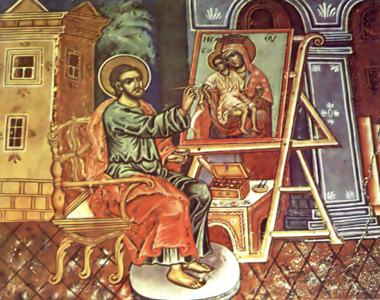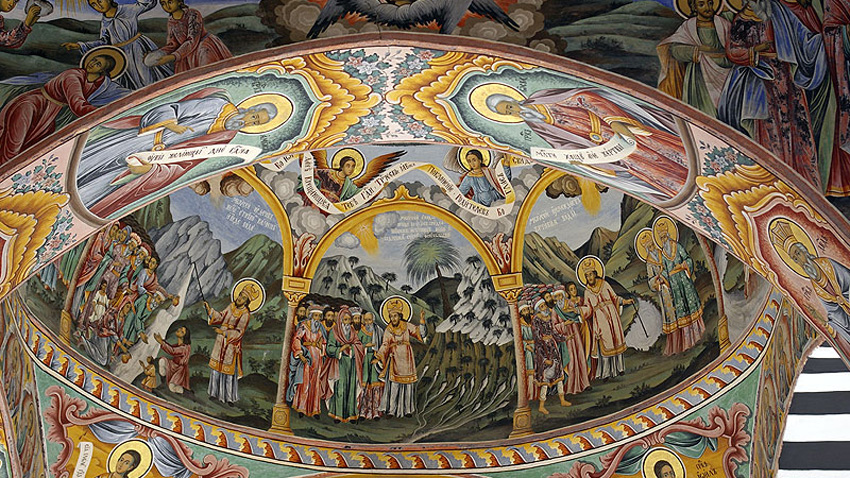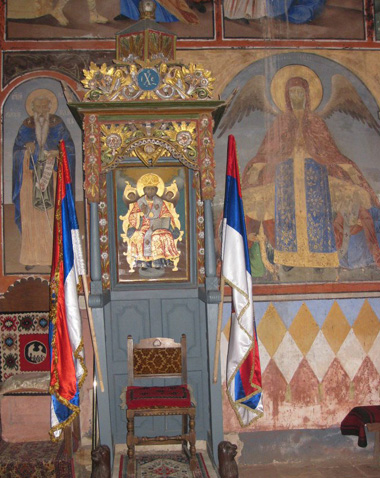
As public relations entered a new stage in the 18th and 19th century, different schools of art took shape in Bulgaria. That was the age of the Bulgarian National Revival; in Western Europe the 18th century was the Age of Enlightenment, a time when the national idea and the national-liberation struggles burgeoned. Education and culture flourished. In the words of Prof. Elena Genova from the Bulgarian Academy of Sciences Institute of Art Studies, that was the time several distinct art schools were formed - in Tryavna, Bansko and Samokov:
“One of the biggest and most notable schools is the Samokov School,” says Prof. Genova. “It was founded by Hristo Dimitrov from Samokov who was trained at Mount Athos. At the close of the 18th century Mount Athos was the hub that absorbed European influences, processed them and then transmitted them, if I may put it that way, to the other Christian Orthodox centres of the Balkans. After his training was over Hristo Dimitrov returned to his home town to continue his work. He trained his sons - Dimitar Hristov Zograf (meaning icon painter) and Zahari Zograf, a name better known to the Bulgarian public.”
 Samokov iconography thrived thanks to three generations of painters. Here is Prof. Genova with more about its evolution:
Samokov iconography thrived thanks to three generations of painters. Here is Prof. Genova with more about its evolution:
“The school followed in the tracks of post-Byzantine painting from the close of the 18th and the turn of the 19th century. But in reality it was swayed by different influences, with the influence of Mount Athos being most direct. Indirect influences came from the Serbian lands where, in the latter half of the 18th and the 19th century art was on the upswing - the so-called Baroque period in the arts in Serbia. The third route that had an indirect influence on art in Samokov and in Bulgaria as a whole, came from Russia and Ukraine. That was where incunabula with engravings tricked in from which people in Samokov absorbed. Hristo Dimitrov also laid the foundations of a huge archive, later continued by his sons that included illustrated bibles and albums with secular drawings and engravings for the icon painters of Samokov to learn from.”
Out of all painters of the Samokov School, Hristo Ivanov's younger son - Zahari Zograf was the name that was to become the most illustrious. “He is the most productive figure in terms of innovation,” explains Prof. Elena Genova.

“Zahari Zograf was known to experiment in many different areas. He created an original decorative system for the churches he worked in - most of all in the monasteries of Troyan and Preobrazhenie (transfiguration)", Prof.Genova further explains. "But I wouldn't say he is the most talented of the icon painters. In our day, with the appearance of new publications about the school of Samokov we see the name of his older brother Dimitar Zograf taking prominence. Zahari is more interesting as a person, but Dimitar's body of work is by far more professional and voluminous. Without making much of a fuss (his brother was far more effusive), Dimitar introduced a host of new elements in ecclesiastical painting - images taken directly or indirectly from Western Europe. Subjects that were very popular during the Bulgarian National Revival began to find their way into ecclesiastical art. The most popular among them were moral and didactic motifs, depicted in the open galleries of the big churches and connected with Judgement Day, the Revelation of St. John, sins, etc., subjects Dimitar expanded on after his father Hristo Dimitrov. The volume of Hristo's work is much smaller and he worked on fewer churches. Dimitar gave free rein to his imagination in the central church at Rila monastery together with his son Zafir, who after graduating the art academy at St. Petersburg took the name of Stanislav Dospevski. He is of the third generation of Samokov painters. Thousands of square meters of frescoes were painted at Rila monastery - a phenomenon unique to the Balkans in that age. The monastery's head icon painter was Dimitar Zograf,” says Prof. Elena Genova and goes on:

“Zahari Zograf is a very vivid figure. Here is an interesting fact from his biography. At the end of his life - in 1851-1852 - a letter came from Mount Athos about painting the open gallery at the Great Lavra, addressed to Zahari's brother - Dimitar Hristov, Yoan Icon-painter and Dimitar Molerov of the Bansko School of art. The letter invited them to paint the open gallery, sending an intermediary ahead to negotiate the conditions for the job. It is thought they chose to send Zahari. Ultimately, however the whole job went into the hands of Zahari, who didn't even consult his older colleagues. I know of a later letter by Dimitar Zograf in which he refuses to work on Mount Athos, as the styles of the two icon-painters was so different that it would not be appropriate for both to be working there.”
 The work of the artists from the Samokov School is far-reaching geographically. They have worked in all corners of what are today the Bulgarian territories, in the Western outlands, in what is today Macedonia. Answering a question whether there are purely Bulgarian ways saints are depicted, Prof. Genova says that this is a culture that has been developing over millennia and that dividing lines should not be drawn between things Bulgarian or non-Bulgarian. In this sense the story of the icon depicting the Holy Mother of God with wings in Sukovo monastery, on the territory of what is today Serbia, is eloquent enough:
The work of the artists from the Samokov School is far-reaching geographically. They have worked in all corners of what are today the Bulgarian territories, in the Western outlands, in what is today Macedonia. Answering a question whether there are purely Bulgarian ways saints are depicted, Prof. Genova says that this is a culture that has been developing over millennia and that dividing lines should not be drawn between things Bulgarian or non-Bulgarian. In this sense the story of the icon depicting the Holy Mother of God with wings in Sukovo monastery, on the territory of what is today Serbia, is eloquent enough:
“It is the story of the shroud of the Holy Mother of God. It is a subject that is purely Ukrainian and comes from Russia and Ukraine. Its appearance in the Bulgarian lands is connected with the convent in Samokov. The founder of the convent had lived in Kiev and when she returned she brought with her the cult of the Holy Mother of God with wings. In these parts she is only depicted by the artists of the Samokov School. The motif of the shroud of the Mother of God originated in Russia long before that - in the 12th century and evolved there over many years, but never with wings. From there it was brought to Western Europe, where it is known as Madonna della Misericordia (Madonna of Mercy), and from Western Europe it went back to Russia and the Orthodox countries in the Balkans. But in Bulgaria it was only the icon painters of Samokov that depict the Madonna - it can well be said it is a motif that is their own, even though its origin is not Bulgarian.”
English version: Milena Daynova
The book "Icons from the National Church Historical and Archaeological Museum" - a huge work of over 500 pages, with more than 700 published photographs and accompanying scientific articles, was officially presented a few days ago. The unique..
A humble military chaplain made his first contact with Bulgaria in 1921, arriving with the mission of searching for Italian soldiers who had disappeared without a trace during World War I. However, he did not remain indifferent to the fate of this small..
Beloslav is a small town on one of the branches of Varna Lake. Yet it is here, in this quiet little town, that the only preserved Bulgarian submarine – Slava – is anchored . It was decommissioned a long time ago, and has now been turned in one of..

+359 2 9336 661
